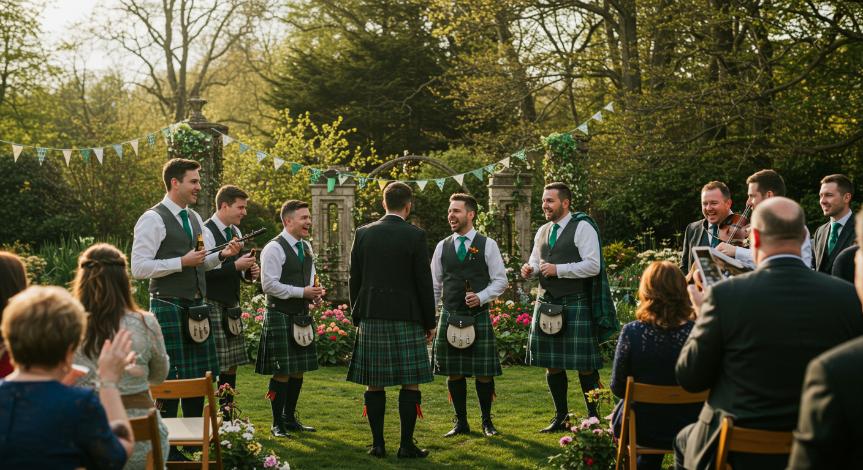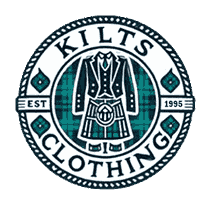The Role of the Irish Kilt in Traditional Ceremonies and Festivals

The Irish kilt is more than just a piece of clothing—it is a living symbol of Ireland's rich history, culture, and traditions. For centuries, people have worn the kilt as a representation of heritage, and it continues to hold deep significance in various ceremonial and festive occasions. Whether worn at a wedding, during St. Patrick's Day celebrations, or at a family gathering, the kilt embodies both the spirit of Irish pride and the deep connections to Ireland's past. This blog explores the role of the Irish kilt in traditional ceremonies and festivals, showcasing how this iconic garment has remained a timeless part of Irish cultural identity.
A Brief History of the Irish Kilt
Before delving into its role in modern-day ceremonies and festivals, it's essential to understand the history behind the Irish kilt. The kilt has its roots in Celtic tradition, with early versions worn by the ancient Gaelic-speaking people. Initially, the garment, also known as the léine, was a loose-fitting tunic, and both men and women wore it. Over time, the kilt evolved into the more recognizable form we see today, a knee-length garment made from woolen fabric, often patterned with various tartans.
Worn for practical reasons, this kilt was especially in rural Ireland, where it provided freedom of movement and warmth. However, they gradually became linked with Irish identity, particularly after the Great Irish Rebellions in the 17th century. During this period, Irish nationalists embraced the kilts irish as a symbol of resistance against British rule. Today, the kilt continues to represent pride in Irish heritage and a connection to ancient customs, especially during special ceremonies and festive occasions.
The Symbolism of the Irish Kilt in Traditional Ceremonies
The Irish kilt carries deep symbolic meaning in many ceremonies. Wearing the kilt during these occasions serves as both a personal and collective act of cultural celebration. Here are some of the most notable ceremonial occasions where the kilt holds significant meaning:
Weddings: A Tradition of Heritage and Family Pride
Irish weddings steep themselves in tradition, with the kilt playing a pivotal role in the celebration. Traditionally, the groom and groomsmen wear the kilt as part of their wedding attire, choosing a tartan that represents their family's heritage. The tartan pattern, which consists of different colored checks or stripes, often signifies the groom's clan or familial roots.
Wearing the kilt at a wedding is a powerful way to honor one's ancestors and celebrate the continuation of family traditions. Many families have their specific tartan, and incorporating this into the wedding attire symbolizes the strength of family bonds and the passing down of traditions through generations. A groom's family often wears their tartan at the wedding. In contrast, the bride's family may choose a complementary design.
Christenings and Naming Ceremonies: A Sign of Continuity
Both Irish men's kilt and women's Irish kilt plays a vital role in christenings and naming ceremonies, particularly for the male members of the family. The godfather or father often wears a kilt as a symbol of their responsibility to continue the family legacy. It is a significant gesture, signifying the passing down of Irish culture and values to the next generation.
By wearing the kilt, the godfather or father expresses his connection to his heritage and symbolizes his role in ensuring the child grows up with an understanding and appreciation of Irish traditions.
Funerals and Memorial Services: A Mark of Respect and Honor
In Ireland, people sometimes wear the kilt during funerals or memorial services to show respect for the deceased and honor family and cultural traditions. The kilt's solemn and dignified nature makes it appropriate for these occasions. Traditionally, individuals might choose a more subdued tartan for such events, avoiding bright colors or patterns but always ensuring that the garment represents the family's pride in their heritage.
Wearing the kilt during a funeral also serves as a way to maintain a connection with one's ancestors, offering a tangible link to the past as the community mourns together.
The Irish Kilt at Festivals: A Celebration of Culture
Festivals have long been a place to showcase Irish culture, and the kilt plays a central role in many of these celebrations. Whether it's St. Patrick's Day, the Fleadh Cheoil, or Celtic festivals worldwide, the kilt is often the garment of choice for those wanting to show their pride in their Irish roots. Here are some of the festivals where you can wear:
St. Patrick's Day: A Global Celebration of Irish Pride
Arguably the most famous celebration of Irish culture, St. Patrick's Day is a day of festivity, parades, and cultural pride. People around the world wear the kilt as part of the festivities to celebrate Ireland's patron saint and honor the country's rich history. In Ireland, wearing the kilt during the St. Patrick's Day parade is a way to express national pride and unity. The tartan pattern, whether it's a traditional Irish design or a modern variation, becomes a visual representation of Irish identity.
St. Patrick's Day has transcended Ireland's borders, with large-scale celebrations in cities across the globe. In countries like the U.S., Canada, and Australia, the Irish kilt is worn by both Irish descendants and people simply wanting to join in the festivities. The kilt, paired with other Irish symbols such as shamrocks, is a recognizable sign of the celebration of Irish culture.
The Galway Races: Racing with Irish Style
At the Galway Races, one of Ireland's premier horse-racing events, people wear the kilt in all its glory. While the event primarily focuses on horse racing, it also gives attendees the chance to dress in their finest. Many choose to wear the kilt as a nod to tradition, adding a touch of elegance to the race day festivities.
Kilts at the Galway Races are often worn with modern touches, such as fitted jackets or stylish hats, combining traditional Irish heritage with contemporary fashion. For both participants and spectators, the kilt is a way to showcase pride in Irish culture while enjoying the vibrant atmosphere of the races.
The Fleadh Cheoil: Music, Dance, and the Kilt
The Fleadh Cheoil, Ireland's largest music festival, is another event where the kilt takes center stage. This festival celebrates Irish music, dance, and culture, and attendees often wear traditional clothing, including the kilt, to participate in the celebrations. The kilt is particularly popular among Irish musicians and dancers, who wear it as part of their performance attire. The garment's history is closely tied to Ireland's musical heritage, making it the perfect choice for this joyous occasion.
The Role of the Irish Kilt in Clan and Family Celebrations
Kilts are also an integral part of family and clan celebrations. During clan gatherings, individuals often wear the specific tartan of their clan to show solidarity and pride. This practice is a direct link to Ireland's feudal past when clans were the central social units, each with its distinctive tartan. Even in modern times, wearing a family tartan during reunions or special family milestones helps preserve the clan's identity and reinforces family bonds.
The Irish Kilt: A Symbol for the Future
The enduring appeal of the Irish kilt lies in its ability to connect generations. Whether people wear it at weddings, funerals, festivals, or clan gatherings, the kilt represents much more than a garment. It is a reminder of the resilience, pride, and enduring spirit of the Irish people. Today, the kilt continues to play a central role in ceremonies and festivals, serving as both a tribute to the past and a celebration of the future.
By continuing to wear the Irish kilt for significant events, we not only honor our ancestors but also ensure that future generations will carry forward this cherished tradition.
Conclusion
The Irish kilt remains an essential element in traditional ceremonies and festivals, representing Ireland's cultural heritage in both solemn and celebratory contexts. Whether worn at weddings, during national celebrations, or as part of family traditions, the kilt connects generations through its rich history and timeless significance. Its role in Irish cultural life is undeniable. As long as people continue to wear it with pride, the Irish kilt will remain a powerful symbol of Irish identity for years to come.


